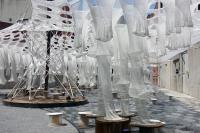Refurbishment BayWa Highrise
Munich, Germany
The headquarters of BayWa AG at Munich’s Arabella Park had become too small. The company envisioned additional storeys for the building dating from the late 1960ties. At the same time, it would provide an opportunity to finally realise the renewal of the old facades and to restructure the offices on all the storeys.
The office of Hild und K Architects is renown for its very sensitive approach to building with existing structures. For Andreas Hild, Dionys Ottl and Matthias Haber the focus point of the planning process was how to deal with the existing building. Its cruciform structure covered in washed concrete slabs makes it appear strangely too short. The solution for the dissatisfactory proportions lay in the optical dissolution of the formerly monolithic building substance into eight building slices arranged in a star-shape and offset to one other. This illusion was to be created by differentiating the cube structure using recesses and by changing the colours of the facades; the building will appear slimmer and more elegant. Additionally, the individual buildings are to be continued with varying heights, creating a silhouette that is both vertically and horizontally staggered. A metal cladding on the additional storeys serves to create an optical whole. The added crown of the building takes up on the cruciform layout of the existing high-rise, whereby the individual building elements are dovetailed similar to the wings on a windmill. The four new storeys develop plastically from the existing structure and can be interpreted as a coherent addition to the high-rise building.
Additional storeys make the heavy washed concrete elements covering the original structure statically no longer feasible. They are to be replaced by a relief façade of thin fibreglass concrete slabs, which interpret the conditions of the existing structure. The shell construction is characterised by pilaster strips between the windows, which originally served to structure the façade. These columns will now be mapped by bending the new skin of the building towards the outside. And corresponding to this, parts of the façade at the parapet bend inwards to where the outer walls were furthest indented in the shell structure. The relief thus created using dovetailed slabs of glass fibre concrete allows for a vivid play of light and shadow, underlined by gentle colour differences of the parts, which meet each other. To avoid ugly grooves in the slab-covered façade, the individual elements are overlapping. The overlaps are backed with dark metal, similar to that used for the additional storeys. These dark-light contrasts, which used to be created by washed concrete in different colours, are reinterpreted and continued in this sophisticated relief.
Contrasting colours also distinguish the two different façade types of the refurbished building from one another. The façade of the old building is dominated by the above mentioned sand coloured glass fibre plates, while large areas of the additional storeys, the receding parts of the façade, smaller one-storey annexes like the foyer and the staff restaurant, all window frames, and the exterior sun protection are made of metal. The metal is covered in a powder coating, which gives it a dark bronze touch.
The same material was used for the facades of the newly created several storey high additional building on the west side of the building. The principle of indents in the concrete facades is carried on here, in the top floors and transferred from the horizontal to the vertical level. Here, too, the relief creates a vivid play of light and shadow. The building is accessed by a foyer, which has similar design details thus making the ensemble coherent. The horizontal composition of the lower annex is underlined through various shades.
Behind all areas of the hinged façade, there is a new layer of insulation to increase the energy efficiency of the building and of which was in dire need. This will improve the work places at the BayWa headquarters, as will the refurbishment of all interiors within the context of the overall renovation measures. Amongst others, the out-dated technical infrastructure in the building will brought up to standard and the small room partitioning will make way for spacious and open structures. Access to the building and the organisation of the rooms is going to be reordered. The staff restaurant, for example is being moved from the north side to the more attractive south of the building. An esplanade joins restaurant, café and the now markedly enhanced foyer and the new annex becomes an attractive free space and meeting area for employees and visitors. On the new 20th floor there is a conference area with an event room, which offers a spectacular view over the whole city. To improve the atmosphere in the previously rather gloomy core of the building, two new large areas of glazing allow light to enter the building on each storey. This “backbone” of light has now become the central access point to all levels, and where central facilities like coffee lounges or meeting rooms are situated. In this way each level of the building now has a social meeting point.
- Architects
- Hild und K
- Location
- Arabellastr. 4, 81925 Munich, Germany
- Year
- 2017
- Client
- BayWa Hochhaus GmbH & Co. KG
- Team
- Matthias Haber, Jan Schneidewind, Philip Argyrakis, Maria Barón, Sérgio dé Sá, Markus Schubert, Claudia Stolte, Susanne Welcker










